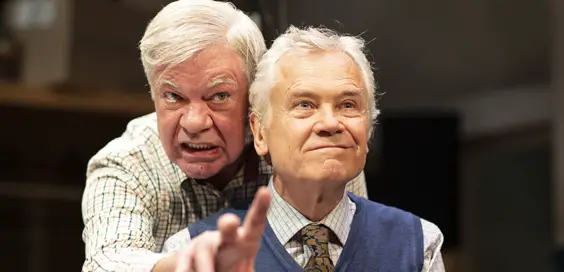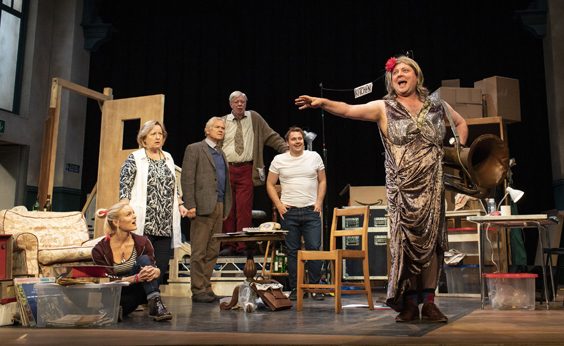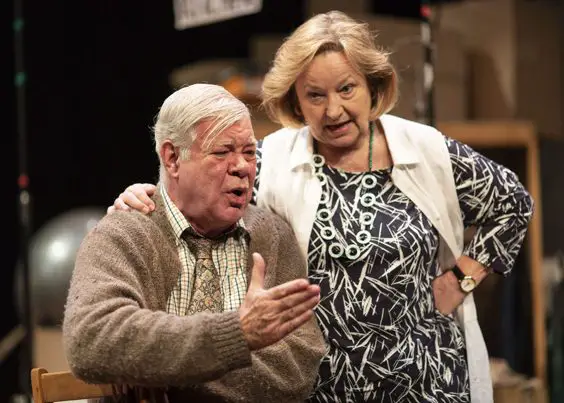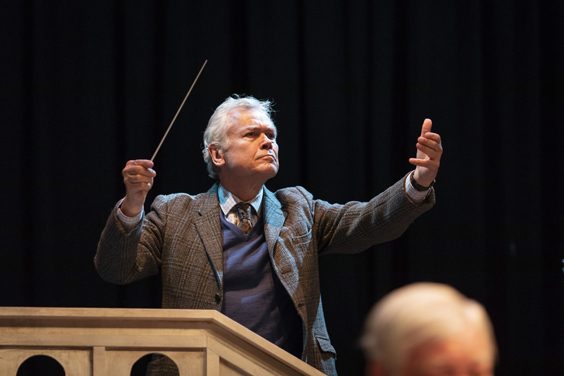The Habit of Art – Review – York Theatre Royal

By Ela Portnoy, September 2018
This is a play that does what it says on the tin; it is a picture, pure and simple, of the habit of art, meaning the practice or livelihood of artists. And what is that? Well, it is an invitation for the audience to do some people watching, or more specifically, do some people watching of artists.
The Habit of Art was (to me, at least) mostly interesting as an exercise in the psychology of all the different groups of people who work on creating a single piece of theatre. It reminds me a bit of the little I have read of Plato – it rings with the idea that art flows from the muse, to the author, to the performer, to the audience. But while Plato treats this art as something supernatural and dangerous which is passed as a divine energy from person to person, there is something very human and messy in Alan Bennett’s play, something about how all the people involved in creating a piece of art are a little bit flawed, a little bit different, a little bit scared of life, and all contribute to something that ultimately reflects human nature.
“Intellectual exercise”
But this messiness is also the downfall of the script. It may be interesting as an intellectual exercise, but it felt dull as a piece of live theatre. Maybe I should come back to it in a few years, maybe it went over my head as I am too young, but I would like to think that regardless of age, a good script should have the audience invested in the narrative.
About 95% of the play is made up of conversations between W. H. Auden and Benjamin Britten, and while I wouldn’t say they were boring, they just felt unnecessary. There was a cast of strong actors all around the two men, who for the most part were just sitting at the side watching the action as a play-in-a-play-in-a-play. If we were supposed to get a glimpse into the creation of a piece of theatre, it was strange how much the script focused on Auden and Britten.
Some of their dialogue was about how artists always leave someone out. So it seemed strange to me that the play was trying to do the opposite on the one hand, and show the perspectives of the rest of the creative team, but on the other hand, doing it so half-heartedly that everyone except Auden and Britten remained a caricature.
“Never-ending internal monologue”
Relatedly it bothered me that in such a male-dominated industry, a play written in 2009 has only two women in a cast of nine, playing the smallest and least significant roles. Some of the other roles in the play could well have been written for women. Perhaps all of this was purposeful, but if so, I can’t see why.
Disappointingly, the script was not saved by the acting. Matthew Kelly (W. H. Auden) was far and away the best actor in the cast. Much of the dialogue of the other actors was overdone, unnatural and dry. In many ways, Matthew Kelly’s role was also better written than the others – he simply had to talk over other people a lot, in a kind of never-ending internal monologue which also seemed to be a self-indulgence of Alan Bennett’s.
Having said that, the set design was beautifully done, and really did give a sense of the tensions between the different layers of people in the creation of the play. We see a huge and incredibly messy rehearsal room with obviously fake doors in the centre where the tiny play-in-a-play-in-a-play stage sits. The real stage then goes all the way out to some very realistic fire exits on the outer edges which serve as the wings.
“Props brought in comedy”
It was the set and props, more than the dialogue and the acting, that served to mark out the difference between the ‘realms’ of stories – Auden’s poetry, Auden and Britten’s conversations, the cast and crew of the play in the story, and the real actors as themselves on stage. And this is what made the metatheatre engaging. The props brought in comedy as well, especially with some obviously fake furniture in Auden’s poetry.
Apart from this, the lighting and sound seemed to blend in except for a strange and seemingly random moment when Auden and Britten were suddenly under spots.
All in all, a strangely written play with some mediocre performances. It raises some interesting themes for an academic discussion, but I felt that it made for an impenetrable piece of theatre.
images: Helen Maybanks












